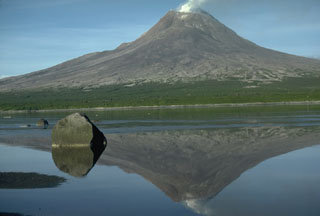Report on Augustine (United States) — 9 August-15 August 2006
Smithsonian Institution / US Geological Survey
Weekly Volcanic Activity Report, 9 August-15 August 2006
Managing Editor: Sally Sennert.
Please cite this report as:
Global Volcanism Program, 2006. Report on Augustine (United States) (Sennert, S, ed.). Weekly Volcanic Activity Report, 9 August-15 August 2006. Smithsonian Institution and US Geological Survey.
Augustine
United States
59.3626°N, 153.435°W; summit elev. 1218 m
All times are local (unless otherwise noted)
AVO reduced the Concern Color Code at Augustine from Yellow to Green on 9 August. Seismic, satellite, and visual data indicated a decrease in activity to background levels. No changes were seen at the summit during the previous several months. AVO warned that the lava dome and surrounding area were still unstable despite the apparent cessation of lava-dome growth. Rockfalls and avalanches were still occurring, especially on the N flank, and may continue for several weeks or months.
Geological Summary. Augustine volcano, rising above Kamishak Bay in the southern Cook Inlet about 290 km SW of Anchorage, is the most active volcano of the eastern Aleutian arc. It consists of a complex of overlapping summit lava domes surrounded by an apron of volcaniclastic debris that descends to the sea on all sides. Few lava flows are exposed; the flanks consist mainly of debris-avalanche and pyroclastic-flow deposits formed by repeated collapse and regrowth of the summit. The latest episode of edifice collapse occurred during Augustine's large 1883 eruption; subsequent dome growth has restored the edifice to a height comparable to that prior to 1883. The oldest dated volcanic rocks on Augustine are more than 40,000 years old. At least 11 large debris avalanches have reached the sea during the past 1,800-2,000 years, and five major pumiceous tephras have been erupted during this interval. Recorded eruptions have typically consisted of explosive activity with emplacement of pumiceous pyroclastic-flow deposits followed by lava dome extrusion with associated block-and-ash flows.
Source: US Geological Survey Alaska Volcano Observatory (AVO)

